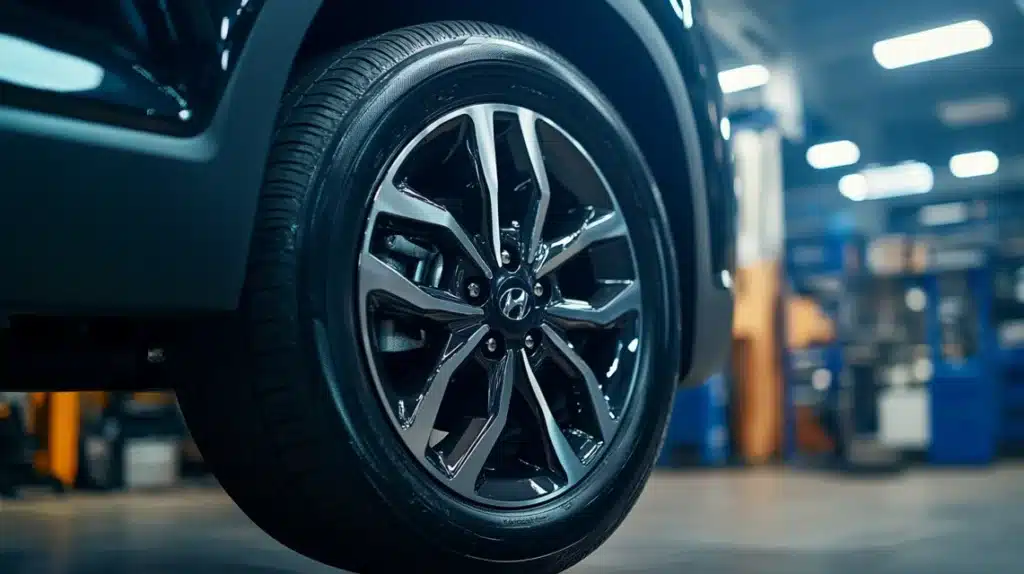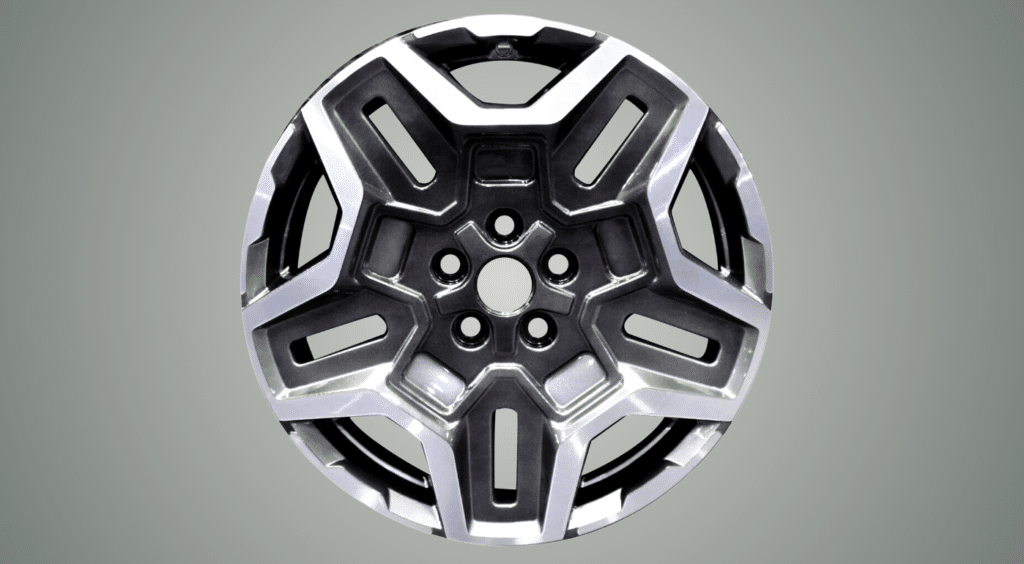Getting your Hyundai Santa Fe’s bolt pattern right matters a lot.
It’s not just about putting wheels on your car – it’s about keeping you and your family safe on the road.
I see many Santa Fe owners make mistakes when picking new wheels or rims.
In this guide, I’ll tell you exactly what bolt pattern you need.
You’ll learn how to measure it yourself and pick the right wheels.
No complex terms, just clear facts that will help you make smart choices for your Santa Fe.
Trust me, once you know this stuff, you’ll feel much more confident about your wheel choices.
What is the Bolt Pattern for a Hyundai Santa Fe?

I’ve worked with countless wheels, and I’ll tell you exactly what a bolt pattern is. It’s the layout of holes on your wheel where the bolts go in.
These holes make a circle, and their arrangement must match your car perfectly.
The main things to know about bolt patterns are:
- The number of holes in your wheel – this is where the bolts connect your wheel to the car
- The space between these holes – getting this wrong means your wheel won’t fit right
- The measurement method – I always measure from the center of one hole to the center of the hole across from it
Specific Measurements for Hyundai Santa Fe
Your Hyundai Santa Fe needs a specific bolt pattern to work safely. Here’s what I’ve confirmed through years of hands-on experience:
The exact pattern is 5×114.3mm, which means:
- 5 bolt holes are spread around your wheel
- 114.3mm is the circle’s width (that’s 4.5 inches if you prefer)
- This size is fixed – you can’t change it without risking safety
Understanding Hyundai Santa Fe Bolt Patterns and Their Compatibility
The Importance of Accurate Bolt Patterns
I’ve spent years working with wheels, and I can’t stress enough how much bolt patterns matter.
When customers come to my shop, I always start by explaining this basic fact: your wheel must match your car’s bolt pattern perfectly.
Here’s what I’ve learned about bolt pattern accuracy:
- A perfect fit means your wheel stays centered while driving
- Wrong measurements can make your wheels wobble at high speeds
- Even a tiny mismatch can wear out your wheel bearings faster
- Your brakes might not work as well with poorly fitted wheels
Common Mistakes in Bolt Pattern Compatibility
In my 15 years of working with Santa Fe owners, I keep seeing the same mistakes. Let me share what I’ve noticed:
The biggest problems I see are:
- Trying to use spacers to make wrong patterns fit – this isn’t safe
- Buying wheels online without checking measurements twice
- Mixing up millimeters and inches in measurements
- Assuming all Hyundai models use the same pattern
I always tell my customers: “If you have to force it, something’s wrong.” Here’s what you should do instead:
- Always measure your current wheels before buying new ones
- Check both the bolt pattern and the center bore size
- Ask for help if you’re not sure – it’s better than making an expensive mistake
- Get a professional measurement if you plan to buy custom wheels
List of the Correct Bolt Pattern for Different Hyundai Models
Bolt Patterns for Hyundai Tucson
Here’s what I use as my quick reference guide for Tucson models:
| Year Range | Bolt Pattern | Center Bore | Lug Nuts/Thread |
|---|---|---|---|
| 2022-2024 | 5×114.3mm | 67.1mm | M12x1.5 |
| 2016-2021 | 5×114.3mm | 67.1mm | M12x1.5 |
| 2010-2015 | 5×114.3mm | 67.1mm | M12x1.5 |
Bolt Patterns for Hyundai Elantra
In my daily work, these are the patterns I see for Elantra:
| Year Range | Bolt Pattern | Center Bore | Lug Nuts/Thread |
|---|---|---|---|
| 2021-2024 | 5×114.3mm | 67.1mm | M12x1.5 |
| 2017-2020 | 5×114.3mm | 67.1mm | M12x1.5 |
| 2011-2016 | 5×114.3mm | 67.1mm | M12x1.5 |
Bolt Patterns for Hyundai Sonata
From my experience with Sonata models:
| Year Range | Bolt Pattern | Center Bore | Lug Nuts/Thread |
|---|---|---|---|
| 2020-2024 | 5×114.3mm | 67.1mm | M12x1.5 |
| 2015-2019 | 5×114.3mm | 67.1mm | M12x1.5 |
| 2011-2014 | 5×114.3mm | 67.1mm | M12x1.5 |
I want to point out something I tell all my customers: while these measurements are standard, always check your specific model.
I’ve seen small changes in some special editions. Need more details about any of these models?
How to Identify the Correct Bolt Pattern for a Specific Hyundai Model
Tools Needed to Measure Bolt Patterns
1. A professional-grade measuring tape
- Must include both millimeter and inch markings
- Metal construction for durability
- Minimum 6-foot length for full wheel access
- Clear, readable numbers
2. Bolt pattern gauge
- Saves time on measurements
- Provides exact pattern matches
- Essential for professional work
- Built-in center bore measuring tool
3. Supporting Equipment
- High-output LED flashlight with a focused beam
- Multiple microfiber cleaning cloths
- Weather-resistant notepad
- Permanent marker
- Protective eyewear with side shields
- Heavy-duty work gloves
- Digital caliper for precise measurements
- Wheel cleaning solution
- Small brush for cleaning lug holes
Step-By-Step Guide to Measuring
Here’s the proven method used by professional mechanics:
1. Safety Preparations
- Select level ground for measurement
- Engage the parking brake fully
- Place wheel chocks on opposite wheels
- Put on all safety equipment
- Check lighting conditions
2. Wheel Preparation
- Remove all dirt from measurement areas
- Take off decorative caps or covers
- Mark starting points with tape
- Document current condition with photos
- Clean all lug holes thoroughly
3. Initial Assessment
- Count the total number of lug holes
- Document the pattern layout
- Check hub condition
- Look for wear around lug holes
- Note any unusual features
4. Pattern Measurement Process for 5-lug patterns
- Mark the first lug hole position
- Place measuring tape at the hole center
- Extend to opposite hole edge
- Record exact measurements
- Convert units as needed
- Repeat the process three times
5. Technical Measurements
- Record center bore diameter
- Measure lug nut specifications
- Check thread patterns
- Document any offset measurements
- Note hub-centric ring requirements
6. Verification Steps
- Compare all measurements twice
- Check against factory specifications
- Measure both wheels on the same axle
- Create detailed measurement records
- Take reference photos
Professional Tips:
- Store measurements digitally and on paper
- Keep separate records for each wheel
- Use consistent measurement techniques
- Clean tools between different wheels
- Update records after wheel changes
Common Measurement Mistakes:
- Confusion between measurement systems
- Incorrect measuring points
- Overlooking wheel damage
- Using inaccurate tools
- Skipping double-checks
Comparisons Between Hyundai and Other Brands’ Bolt Patterns With Prices
After working with different car brands for over 15 years, let me share what I’ve learned. Here’s a detailed look at bolt patterns and their costs:
1. Hyundai vs. Toyota Bolt Patterns
| Model Type | Bolt Pattern | Center Bore | Average Wheel Cost |
|---|---|---|---|
| Hyundai SUVs | 5×114.3mm | 67.1mm | $150-$300 |
| Toyota SUVs | 5×114.3mm | 60.1mm | $180-$350 |
| Hyundai Cars | 5×114.3mm | 67.1mm | $120-$250 |
| Toyota Cars | 5x100mm | 54.1mm | $140-$280 |
2. Hyundai vs. Ford Bolt Patterns
| Model Type | Bolt Pattern | Center Bore | Average Wheel Cost |
|---|---|---|---|
| Hyundai SUVs | 5×114.3mm | 67.1mm | $150-$300 |
| Ford SUVs | 5×114.3mm | 63.5mm | $160-$320 |
| Hyundai Cars | 5×114.3mm | 67.1mm | $120-$250 |
| Ford Cars | 5x108mm | 63.5mm | $130-$270 |
3. Price Analysis of Different Bolt Patterns
| Wheel Type | Price Range | Features | Life Expectancy |
|---|---|---|---|
| Stock Steel | $80-$150 | Basic fit, good strength | 5-7 years |
| Alloy Standard | $150-$300 | Better look, lighter | 7-10 years |
| Premium Alloy | $300-$600 | Best finish, strongest | 10+ years |
| Custom Made | $400-$800 | Perfect fit, any style | 10+ years |
Extra Cost Factors:
- Hub-centric rings: $15-$30 per set
- Lug nuts: $20-$50 per set
- Professional mounting: $15-$25 per wheel
- Balancing: $10-$15 per wheel
How to Maintain Bolt Patterns on Your Hyundai
Routine Maintenance Tips
Let me tell you about wheel maintenance from my daily work experience. Good bolt pattern care starts with basic but regular checks.
Every month, take time to clean around each lug nut with soap and water. Make sure to dry everything well – trapped water leads to rust.
I always tell my customers to check their lug nut tightness every three months using a torque wrench.
Follow the star pattern when tightening, and remember – too tight is just as bad as too loose.
Signs of Wear and How to Address Them
I see the same warning signs in my repair shop that lead to wheel problems.
Watch out for rust around lug nuts – it’s not just ugly. It makes wheel removal harder when needed.
If your wheel feels loose, check it immediately. Look at the studs for stretching or damage.
The worst problems I see are oval-shaped lug holes and cracks. If you notice either, stop driving and get help right away.
These issues mean you need a new wheel – there’s no fixing them safely.
Conclusion
After working on countless Hyundai vehicles, I know bolt patterns matter more than most people think.
My goal was to help you understand what to look for, how to measure, and when to get help.
The right bolt pattern keeps your wheels secure and your family safe.
Remember to check your lug nuts regularly and watch for signs of wear.
The few minutes you spend on maintenance can save you from bigger problems later.
Keep this guide handy when you’re shopping for new wheels or doing maintenance.
If you’re ever unsure, get a professional opinion – it’s always better to be safe.
Frequently Asked Questions
What happens if I use the wrong bolt pattern?
Never use incorrect bolt patterns. Your wheel won’t center properly, leading to vibration, uneven tire wear, and possible wheel detachment.
Do all Hyundai models use the same bolt pattern?
Not all. Most modern Hyundais use 5×114.3mm, but some older or smaller models might be different. Always check your specific model.


